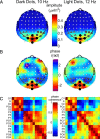Bottom-up biases in feature-selective attention
- PMID: 23175846
- PMCID: PMC6621795
- DOI: 10.1523/JNEUROSCI.1767-12.2012
Bottom-up biases in feature-selective attention
Abstract
Previous studies of feature-selective attention have focused on situations in which attention is directed to one of two spatially superimposed stimuli of equal salience. While such overlapping stimuli should maximize stimulus interactions, it is still unknown how bottom-up biases favoring one or the other stimulus influence the efficiency of feature-selective attention. We examined the integration of bottom-up contrast and top-down feature-selection biases on stimulus processing. Two fully overlapping random dot kinematograms (RDKs) of light and dark dots were presented on a gray background of intermediate luminance. On each trial, human participants attended one RDK to detect brief coherent motion targets, while ignoring any events in the unattended RDK. Concurrently, through changes in background luminance, stimulus contrast could be set to five different levels: the stimuli could either be equal, or one of the two stimuli could have twice or four times the contrast of the other stimulus. This manipulation introduced a bottom-up bias toward the stimulus with the higher contrast while keeping the difference between the stimuli constant. Stimulus processing was measured by means of steady-state visual evoked potentials (SSVEPs). SSVEP amplitudes generally increased with higher contrast of the driving stimulus. At earlier levels of processing, attention increased the slope of this linear relation, i.e., attention multiplicatively enhanced SSVEP amplitudes. However, at later levels of processing, attention had an additive effect. These effects of attention can be attributed to the differential integration of gain enhancement and inhibitory stimulus competition at different levels of the visual processing hierarchy.
Figures



References
-
- Andersen SK, Müller MM, Hillyard SA. Tracking the allocation of attention in visual scenes with steady-state evoked potentials. In: Posner MI, editor. Cognitive neuroscience of attention. Ed 2. New York: Guilford; 2011a. pp. 197–216.
-
- Andersen SK, Fuchs S, Müller MM. Effects of feature-selective and spatial attention at different stages of visual processing. J Cogn Neurosci. 2011b;23:238–246. - PubMed
-
- Banton T, Levi DM. The perceived strength of motion-defined edges. Perception. 1993;22:1195–1204. - PubMed
-
- Boynton GM. Attention and visual perception. Curr Opin Neurobiol. 2005;15:465–469. - PubMed
Publication types
MeSH terms
LinkOut - more resources
Full Text Sources
